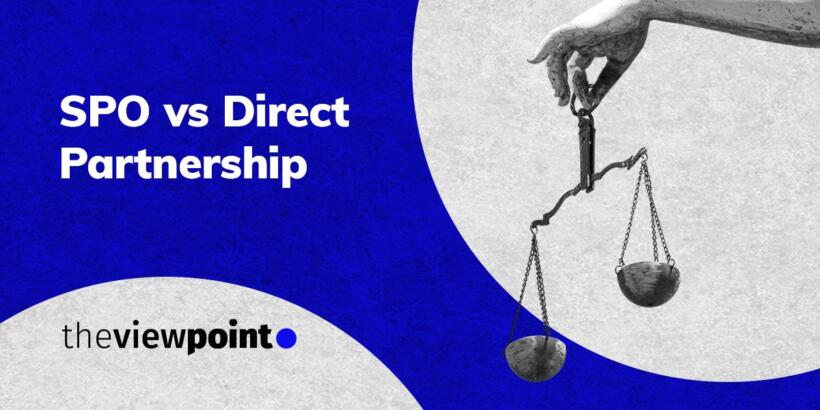
Advertisers’ scale Pan: What’s the weight difference between SPO and direct partnership?
The connected TV (CTV) market is growing by leaps and bounds and it’s expected that technology penetration into US households alone will reach approximately the 82% mark by 2023. Despite digital television already establishing itself as an efficient advertising channel, there are still challenges to be resolved. For the time being, one of the main roadblocks obstructing ad dollars here is the lack of supply chain transparency. The gap between advertisers and publishers is ubiquitously filled with dozens of intermediary actors and altogether they shape a so-called supply chain.
On one hand, there’s a reason for everything and these intermediaries earn their corn as they actually link advertisers with publishers and help to deliver an impression to the destination ad spot. On the other hand, the commissions they take ultimately cost too much for publishers, and this surely affects pricing for the demand-side as well. Thereby, the adtech industry players are revising the approach in ad selling and are looking for workarounds to reduce expenses and define the most valuable traffic sources. This is what they call supply chain optimization (SPO), which is the process of optimizing their operational expenditures. So let’s shed some light on key barriers in this way, and what options are available to move the needle.
The perplexity of the estimation
Each supply-side platform (SSP) possesses a certain pool of its own supplies (resources where an ad can be displayed). For advertisers, each supplier is an inventory purchase option. So the more suppliers they can choose from to buy an ad, the higher the competition between sellers is. As economics 101 suggests, a surplus of supply brings a decrease in pricing. For this reason, it’s a common practice among advertisers to engage as many SSPs into media buying as possible, but the truth is that such a ‘wide grip’ leads to opaqueness within the chain and hits brands’ wallets.
Since header bidding allowed publishers to stack bids from myriads of SSPs simultaneously, it’s enough for advertisers to operate with just three or four of them to cover a desirable scope of inventory. Thus, if the involvement of SSPs is overdone in the auction, it will only increase the number of middlemen within the chain and won’t improve the quality of supply. So the trick here is to estimate a sufficient number of suppliers.
And every single intermediary means another financial burden for the ad budget. To avoid an overabundance here and reduce rudimentary links, advertisers go for supply path optimization. The SPO aims to define the best path to the impression at a minimum fee rate. But even a perfectly calibrated route is not the shortest one. So what’s that blueprint that brings brands and publishers together and ultimately close within digital TV advertising?
Direct partnership – a time-tested model
The direct partnership throughout CTV ad buying has been an on-the-go model for almost a decade. For now, when the number of players has ballooned, it’s not so easy to establish a first-hand relationship, but still this is the paradigm that business is trying to stick to.
We are living in a helix-like world where history moves cyclically. Each new cycle is intended to bring improvements and evolve regardless of the sphere we are talking about. The adtech market is not an exception from this principle. Thus, the direct partnership concept was rethought by TheViewPoint, a software as a service (SaaS) ad monetization platform for CTV and over the top (OTT) publishers that aims to build an intelligent, fair business model. So, the concept encompasses both the buying and selling parties and a tech vendor to host their deals as well.
Why should publishers and advertisers attempt to establish a one-on-one partnership? It’s simple – with a trustee direct model that encompasses ‘sellers.json‘ and ‘ads.txt-series‘ anti-fraud remedies, advertisers get guaranteed high-quality impressions at clear and fair terms, so there is no obscurity about where the money flows. Meanwhile, publishers receive the highest revenue for their inventory, as they are getting paid at full price that the advertiser pays without any opaque and unexpected charges. The only extra billing here is a flat fee to a tech vendor, so the publisher can project his budgets with accuracy. Now that’s the state of play the ecosystem is striving towards.
This is a great ‘opportunity window’ for advertisers and publishers to forge new business relationships and improve transparency. Moreover, the ‘one-on-one’ CTV ad purchase model is a solid response to unattributable ad budgets, as well as to the walled gardens’ oligopoly. Digital advertising parties should toil on networking, discuss troublesome moments and, all in all, create meaningful partnerships. Cohesive interaction and communication are the foundation of a thriving business in the CTV environment.
Summing up
Despite CTV advertisers being ready to fork out for rudiment intermediary commissions, they’re still frustrated with the black-box nature of the long and veiled supply chains. For the time being, advertisers consider easily accessible routes with SSPs. Meanwhile, a direct partnership is also a part of this game and it has an up-to-date transparent approach with the ‘sellers.json‘ and ‘ads.txt-series‘ standards on the board. So basically, both options are capable of meeting brands’ expectations. Both pans have a fair weight, and advertisers decide which one to choose. Yet, let’s keep this in mind – the future will only reveal the best of them.
This content was originally published on The Drum.

